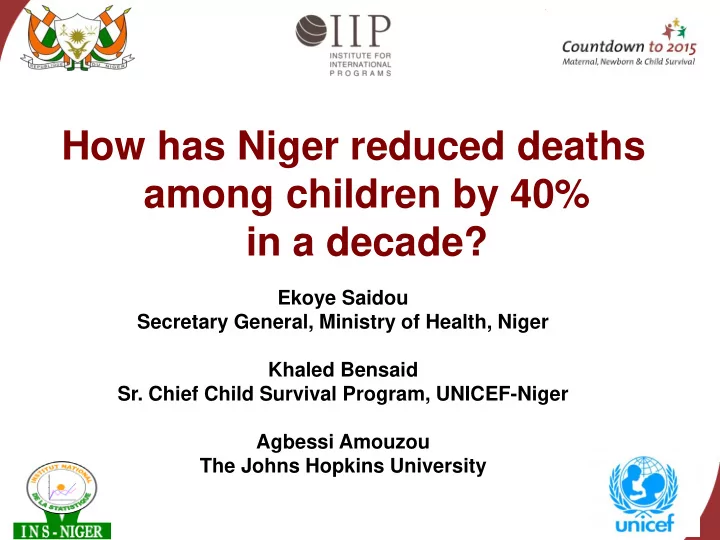

How has Niger reduced deaths among children by 40% in a decade? Ekoye Saidou Secretary General, Ministry of Health, Niger Khaled Bensaid Sr. Chief Child Survival Program, UNICEF-Niger Agbessi Amouzou The Johns Hopkins University
BACKGROUND : CONDITIONS, POLICIES AND PROGRAMS
Niger: A land of challenges Landlocked; 80% Sahara desert Population 15.7 million World’s highest fertility rate (7.1 per woman) Poor: o GDP per capita: US$278 o 59.5% of population below poverty line o In 2011, ranked186 of 187 countries on the Human Development Index
Three major child survival strategies since 2000 1. Increased access to primary health care for major child killers (malaria, pneumonia, diarrhea, measles) 2. Mass campaigns for rapid scale-up of insecticide-treated nets (ITNs), measles vaccination, and vitamin A supplementation 3. Intensified efforts to address child undernutrition
NIGER CASE STUDY: METHOD AND RESULTS
Under-five mortality declined; no significant change in neonatal mortality U5MR NNMR 300 Deaths per 1000 live births 250 Percent annual rate of decline in U5MR: 5.1% 200 150 100 50 0 1996 1998 2000 2002 2004 2006 2008 2010 Year
Wasting is down sharply; only small decline in stunting 70.0% 12.0% % children moderately or severely stunted 60.0% % children severely wasted 10.0% 50.0% 8.0% 40.0% 6.0% 30.0% 4.0% 20.0% 2.0% 10.0% 0.0% 0.0% 1998 1999 2000 2001 2002 2003 2004 2005 2006 2007 2008 2009 Moderate or severe stunting Severe wasting
New policies were effectively implemented Health service indicator 1998 2009 Number of functioning health posts 0 1938 % population living within 5km of health 48% 80% post or health center CHWs trained in management of 0 2308 childhood illness % of children with fever/cough for whom 23% 54% care was sought outside the home
Dramatic increases in coverage across the continuum of care, 1998 to 2009 100 80 60 40 20 0 1998 2009
Almost 60,000 children’s lives saved in 2009! Proportion of child lives saved in 2009, by intervention or risk factor reduction Careseeking Careseeking for malaria Vit A for pneumonia 9% supp. 8% 9% ORS + Zinc Reduction 5% in wasting 9% Measles Reduction vaccine in stunting 5% 19% lives 10% saved Hib vaccine 4% Others (<2% each) Changes in BF practices 3% 11% ITN TT in preg 2% ownership 25%
IMPLICATIONS FOR NIGER AND THE REGION
Lesson 1: Access to quality services matters! Key factors for success included: Abolishing user fees for women and children and moving services closer to the communities where children live Mass campaigns to reach many children quickly with priority interventions Recognition of nutrition’s key role in survival, and full integration into programming
Lesson 2: Stay the course! Translating supportive policies into effective programs that reduce mortality takes time Programs must evolve to incorporate new delivery strategies and interventions These efforts must continue and intensify – to save more newborns, to further increase coverage, and to reduce child mortality still further!
Lesson 3: Good data + in-country analysis = effective programs Regular, high-quality survey data on intervention coverage is essential Building local capacity to analyze and use data enables evidence-based actions Program monitoring is time- and resource- intensive, but is a key part of program management
Thank you from the Niger Countdown Case Study Team For Financial support: For Technical support: Bill & Melinda Gates MOH, Niger Foundation INS, Niger Governments of Australia, UNICEF Canada, Norway, Countdown to 2015 Sweden, and the United CHERG/LiST Kingdom LSHTM The World Bank IIP / JHSPH
Recommend
More recommend